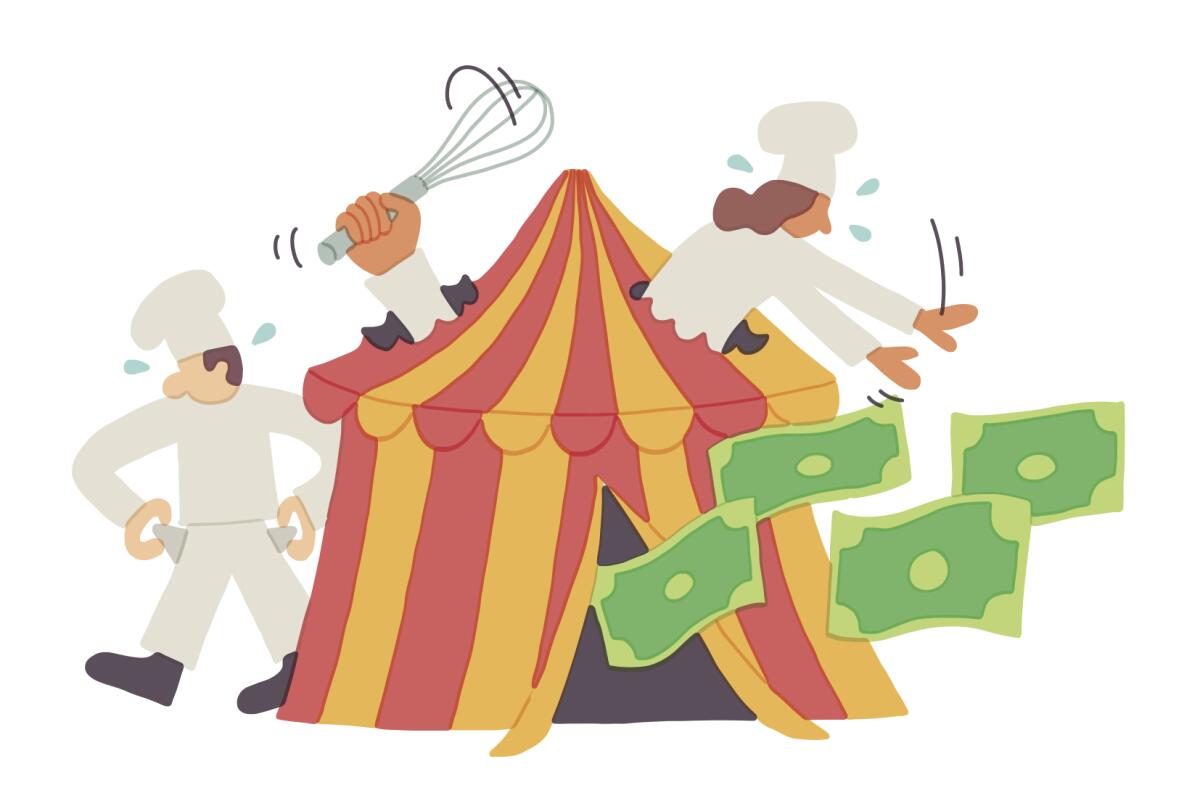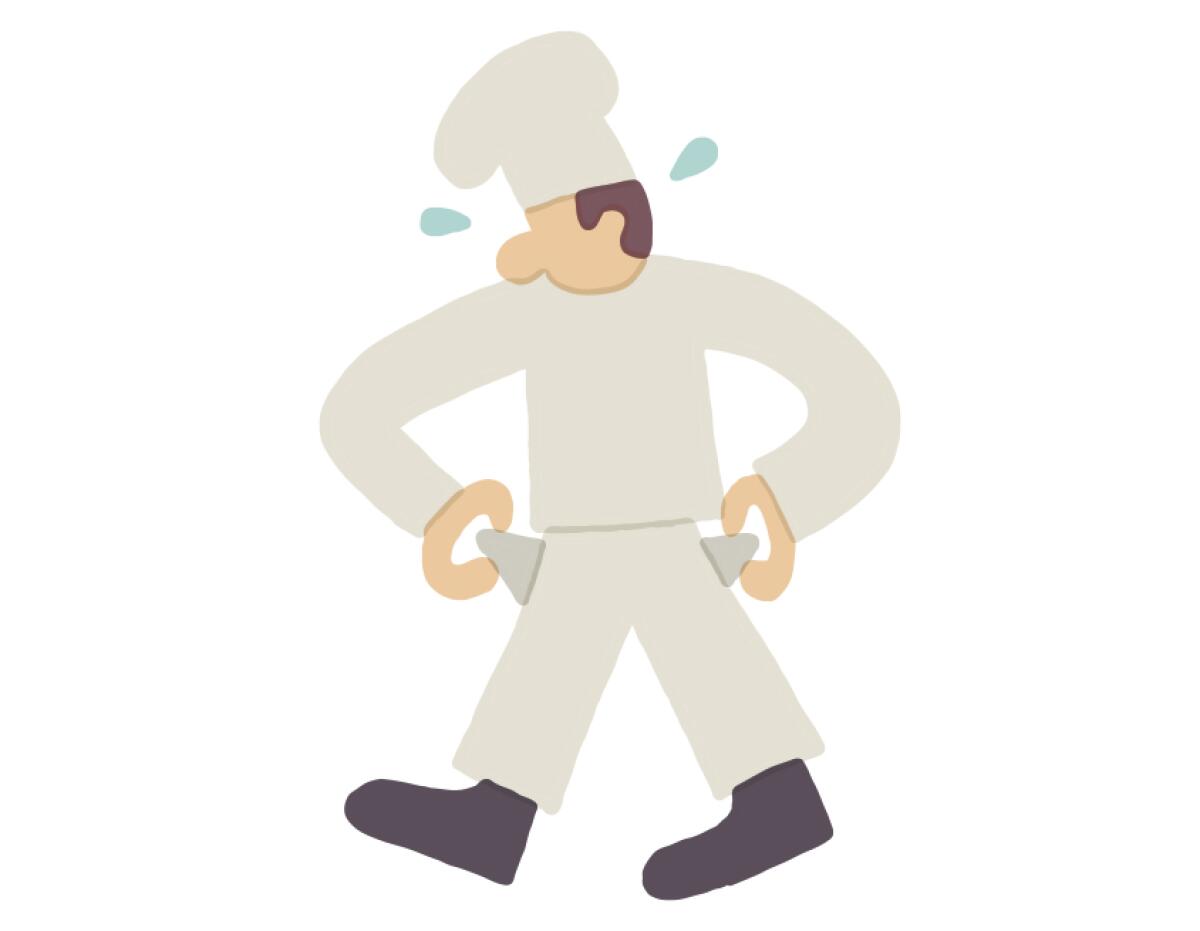The Festival Industrial Complex: How food festivals hurt the chefs they’re meant to help

- Share via
This article was commissioned in conjuction with the Southern Foodways Alliance and will be presented at the 22nd annual Southern Foodways Symposium, Oct. 24-26 at the University of Mississippi in Oxford. For 2019, SFA has explored the labor of food through symposia, journalism, documentary films and other media.
The sandwich-making was fake.
Chefs from FIG, a fine-dining restaurant in Charleston, S.C., had worked their share of food events. Certainly enough to know there was no easy way on a Charleston Wine + Food Festival stage to produce the grilled cheeses it would take to satisfy throngs of ticket holders with commemorative wine glasses yoked around their necks. So they griddled hundreds of sandwiches in advance and pretended to butter and flip them once the grilled cheese showdown was underway. But they still couldn’t quite keep up.
The heckling was real.
“Where’s our food?” the crowd chanted, closing in on the chef contestants. “We want the food!”

“It was so crazy,” remembers Sarah Adams, a former FIG sous chef. “They were drunk on flavored vodka and getting aggressive. We were like, ‘This is not the kind of person who would ever eat at FIG.’”
In return for its appearance, FIG was promised exposure and the opportunity to demonstrate its support of the local culinary community. The festival supplied some cheese and set up grills, but the restaurant had to foot the cost of other ingredients, prep time and space in its kitchen as well as Adams’ salary.
They were drunk on flavored vodka and getting aggressive. We were like, ‘This is not the kind of person who would ever eat at FIG.’
— Sarah Adams, a former chef at FIG
Food festivals are more popular and more elaborate than ever, but what’s not apparent to ticket buyers is that their growth has often been at the expense of the restaurants and chefs they’re supposed to promote.
A restaurant as successful as FIG can typically absorb the high costs of food-festival participation, but many can’t. Little-known chefs stand to be financially and philosophically crushed by the industry expectation that they cook at food festivals for little or no money. While compensation varies according to the festival and chef, it’s generally understood that most chefs will end up paying upward of $1,000 to distribute their bite-sized food samples under a tent.
Festivals “pay for electricity,” says cookbook author Ronni Lundy, who’s frequently asked to moderate panels and conduct cooking demos at festivals. “They pay for a hall; they pay for advertising; they pay for television coverage. What they don’t pay for is the content of the event.”
Or as chef John Currence, owner of City Grocery in Oxford, Miss., and the Big Bad Breakfast chain, puts it: “They’re putting on a Bonnaroo and not paying the bands.”
Bonnaroo is an apt comparison, since the success of music festivals led to the format being adopted by event organizers around the country as a way to showcase chefs. While early 20th century food festivals tended to celebrate a region’s most successful crop, such as persimmons in Mitchell, Ind., or spinach in Lenexa, Kan., food festivals in the first decade of this millennium came to mean glitzy dinners with guest chefs; “Iron Chef”-style competitions and, always, tasting tents.
Among the best-known festivals are the South Beach Wine & Food Festival (2002); Charleston Wine + Food Festival (S.C., 2006); New York City Wine & Food Festival (2007); Atlanta Food & Wine Festival (2010) and Feast Portland (Ore., 2011). Nearly every U.S. eater now lives within driving distance of a chef-centric festival.
Host cities hail them as economic drivers and clear indicators of their food-and-bev cred. After R.W. Apple of the New York Times filed a glowing report from the first Charleston festival, the city’s convention and visitors bureau received 2,000 requests for information from potential visitors, close to a one-day record. That’s the kind of statistic that any city is likely to find inspiring.
They’re putting on a Bonnaroo and not paying the bands.
— John Currence, chef-owner of City Grocery in Oxford, Miss., and the Big Bad Breakfast chain
Despite the increase in food festival supply, ticket prices have skyrocketed. During its first year, the Charleston Wine & Food Festival sold day passes to its “culinary village” for $25 apiece; in 2020, five hours in the Culinary Village will cost $135. Like many food festivals, Charleston offers a slate of other events, including meals, beverage seminars, house parties and fitness classes; the average cost of admission to a single event is $154.06.
When Matthew Raiford of Gilliard Farms in Georgia first started working the festival circuit, he had no idea how much people were paying to try the food he supplied for free.
“They charge what? For this?” he remembers thinking. “Let’s do simple math: They get 230 people at $200 per person. That’s $40,000. What?”
Still, chefs keep saying yes when food festivals come calling. Chefs interviewed for this story say the decision usually depends on two factors: They’re anxious for potential customers, restaurant backers or James Beard Foundation award voters to see them. Or they want to see their food industry friends. Food festivals offer a chance for chefs to get out of their kitchens and kibitz with colleagues.

“I’ve never worked a festival where it was particularly financially viable, but we just really love to cook with other chefs,” says Molly Maciejewski, executive chef of Sourdough in Madison, Wis. “I mean, exposure: I don’t know how you quantify that. The value of exposure gets overstated a lot by people who want chefs to work for free.”
Exposure is perhaps more valuable to upstarts than it is to established chefs. Robin Wong of Blood Bros. BBQ in Houston said he and his brother, Terry, parlayed appearances at Texas barbecue festivals into a permanent location. For a pop-up, he says, “When you’re next to guys like Ronnie Killen and Wayne Mueller,” two of the state’s most respected pitmasters, “you automatically get credibility.”
Wong likens festival participation to an ad buy. “We make no money, but probably half of our customers found us there,” he says. Still, Blood Bros. BBQ last year made adjustments: Rather than pay out of pocket to pad the $800 they received to feed approximately 2,000 people at the Houston Barbecue Festival, the Wongs made sausage.

“Sausage you can stretch a long way,” Wong says, echoing generations of cash-strapped cooks. “A festival-goer might be like, ‘I paid 100 bucks for this ticket, and you guys are serving sausage?’ But on the opposite end of that, it’s all we can afford to serve.”
Now that the Wongs work out of a building instead of a parking lot, they sign up for fewer festivals. Wong says that running a restaurant changes chefs’ calculations of what they stand to gain and lose by devoting a day to vending in a park.
Since Currence has shifted from working in a kitchen to overseeing a collection of restaurants, he has largely bowed out of festivals, save for friends’ charitable events. Over the years, though, he developed a knack for festival accounting. Here’s how Currence does the math when a festival asks him to join one of its hometown chefs to prepare a seated dinner for 100 people:
Typically, he would be offered a $250 travel stipend in exchange for his participation. Because Currence is based in north Mississippi, airfares to major cities are often high. According to the latest report from the U.S. Department of Transportation, the average domestic ticket out of Memphis International Airport is $386.12.
To pull off a dinner for 100 that reflects well on Currence and his restaurants, he needs to bring two cooks with him. So he estimates actual travel cost is around $1,000, plus $150 in ground expenses.
If Currence rents two decent hotel rooms for three nights, he’s looking at another $750. He also has to feed his crew. There’s a benefit to supplementing his employees’ culinary education, so Currence is reluctant to stint on dining: He budgets $400 for meals with colleagues. Plus, he pays their wages, and the wages for the cooks called to fill in back at the restaurant. He figures that’s another $800.
Finally, Currence is on the hook for ingredient costs. At $20 a plate for each of the 100 diners, that’s $2,000.
“Pretty quickly, that hypothetical spitball is going to be around $5,000,” he says.
Not every chef has to travel a long distance to a festival or pay for support staff. But for a chef just starting out, a four-figure expense can crater his or her bottom line. And Lundy points out that chefs who traditionally have the least resources are often the chefs most likely to accept costly invitations: “It’s extremely hard for women and African Americans who are being told, ‘It’s a gift to be let in’ to ask for what they’re worth,” she says.
“You’re not José Andrés, right?,” Raiford says, referring to the chef and humanitarian who can command $40,000 in appearance fees. “People worry, ‘Will he do it?’ When they call Matthew Raiford, they’re like, ‘We can probably get him for lodging and travel.’”
If festivals covered even a fraction of the items tallied by Currence, their costs would mount quickly, which is why festival professionals trying to address the problem aren’t gravitating toward flat fees. For example, the Atlanta Wine & Food Festival this year listed 143 chefs, sommeliers and other food professionals as featured “talent.” If each of those people commanded $1,500 in fees, the festival’s bill for talent alone would approach a quarter-million dollars.
Compounding chefs’ frustration with the current festival model is the windfall money that buzzy festivals reap in sponsorships and ticket sales.

“The question is how much profit these festivals are getting,” says Edouardo Jordan, a Seattle chef and restaurateur.
Austin Food + Wine Festival in 2016 reported $315,613 in revenue, according to tax records. Memphis Food & Wine collected $382,845 in the same year. And the Charleston Wine + Food Festival took in nearly 10 times as much, reporting $3,116,921 in revenue.
With such large pools of money from which to draw, festivals’ spending decisions are carefully scrutinized by unpaid participants. Chefs across the Southeast can quote the Charleston Wine + Food Festival executive director’s salary ($104,143), and how much local and state tourism groups paid for the “Today” show to film on festival grounds ($280,000).
Gillian Zettler, director of Charleston Wine + Food, declined to be interviewed for this story, but a festival spokeswoman says the “Today” show bill was covered by funds earmarked for tourism promotion. The director’s salary, she adds, recognizes “nonprofit trends” and Zettler’s work stabilizing the festival’s finances.
Charleston Wine + Food has come under fire for its allocations in part because the nonprofit is required by law to make its figures public. Many food festivals are privately run, and under no legal obligation to disclose their earnings or expenditures. Others, such as the South Beach Wine and Food Festival, are affiliates of larger agencies or institutions.
Last year Florida International University conducted an internal audit of South Beach Wine and Food, which is jointly hosted by the school and Southern Glazer’s Wine & Spirits, to determine whether its financial practices conformed to the school’s policies: A previous audit, performed in 2012, gave the festival a failing grade in two out of five categories. Auditors at that time were concerned about the festival spending $131,000 on 7,500 copies of a cookbook authored by the festival director; unauthorized first-class flights and a potential conflict of interest involving $43,000 paid to a catering company co-owned by a faculty member.
South Beach fared much better in its latest audit, although auditors noted “opportunities for improvement.”

According to the report, the festival in 2017 generated just over $9 million in revenue, with the income coming in almost equal measure from sponsors and the festival’s 60,000 attendees. Auditors recommended tighter controls on spending, noting a supplier of cookware, plates and utensils was overpaid by $42,000, a $17,922 bill from Loews Hotel was mistakenly paid twice and a sign company was overpaid by $3,842.
Participating chefs, by contrast, aren’t paid at all. “Our festival is a charity with 100% of the net proceeds benefiting the Chaplin School of Hospitality & Tourism Management at Florida International University,” spokeswoman Devonie Nicholas says. (Nicholas’ explanation of compensation was provided in response to a survey sent by this reporter to 20 food festivals.) “All participating talent donate their time and talents to the festival, which helps us raise funds for the school.”
The question is how much profit these festivals are getting.
— Edouardo Jordan, a Seattle chef and restaurateur
South Beach Wine and Food’s annual contribution in 2017 consisted of $482,407 transferred to the FIU Foundation to establish a scholarship endowment, and $959,600 to the Chaplin School, which uses the money to fund scholarships and pay faculty salaries.
Nicholas added that the festival “offer(s) reimbursement up to a certain amount for chefs participating in our Grand Tasting Village, due to the large number of portions we request” and sometimes supplies “travel and accommodations assistance.” Of the festivals contacted, the Epcot International Food & Wine Festival and Hawaii Food & Wine Festival declined to complete the 10-question form. Another six festivals did not respond to repeated messages. And seven festivals acknowledged receiving the survey but didn’t return it.
From the small sample of five surveys received, a clear theme emerged: Food festivals like to tout their charitable giving. Asked if chefs are given an ingredient budget, a publicist for Euphoria, a festival in Greenville, S.C., wrote, “Euphoria is a small nonprofit. Chefs who come to our festival agree to donate their food costs and their time.” Asked if chefs receive any kind of stipend, she wrote, “We are a small nonprofit, so we do not pay a stipend for chefs.”
In 2016, Euphoria distributed $24,000 in grants to community organizations. This year’s beneficiaries were the S.C. School for the Deaf and Blind, Greenville Tech Foundation and Legacy Early College.
Chefs interviewed for this story say they appreciate festivals’ commitment to giving back. But many of them have other charitable priorities, and wish festival organizers wouldn’t hide behind those causes when they decline requests for a better event assignment or bigger food budget.
As one of her side hustles, Adams, the freelance chef who quasi-grilled cheese on FIG’s behalf, sets up selfie stations. Charleston Wine + Food wanted her to bring her booth to one of its events, so she asked how much it would cost.
“I sent them a financial package, and they were like, ‘No, I don’t think so. We’re a nonprofit,’” Adams says, repeating what fellow chefs say is a constant refrain when they ask for money. “My donations go to women’s causes. That’s my thing. Any sort of women’s cause, I’m down. But I’m a small business. I’m not giving this away.”
A festival spokeswoman confirmed the festival requests a nonprofit rate from “all of our potential partners.”
Festival organizers note that there’s also a lot of money at stake for them.
Some describe an annual struggle to stay afloat. “These events are super-challenging to rally support for, because there are so many food-and-beverage-related events competing now,” says Colleen Minton, founder of TerraVita, a Chapel Hill, N.C., festival now in its 10th — and final — year; Minton cited personal reasons for her decision to halt the event.
Despite those challenges, new food festivals are introduced every year by cities and, increasingly, by media organizations. (The Times hosts several food events throughout the year.)
In addition to the stress of cooking at such a high level that food writers take notice and festival-goers pocket your business card, small restaurant owners also have to deal with the fallout from their regulars back at home.
“You’re posting pics of this great time you’re having at this mad food festival, and your community is like, ‘You’re where? Who’s cooking the food here, then?’” Raiford says. “Customers are going, ‘Oh, that’s why the cheesecake didn’t taste the same.’”
Years ago, chefs agree, the promise of drinking with friends and sharing their latest dishes with adoring eaters was reason enough to pony up money for a festival spot that would set them back financially.
Now, chefs mostly want to feel appreciated.
“It’s the little things,” Currence says. “Chefs want six to eight bottles of water in their room. They need some popcorn and granola bars.” He contrasts that kind of useful gift with the standard swag bag holding a candle and a branded thumb drive.

“It doesn’t make sense for a chef to show up for free and go home without even a bottle of whiskey or book to show for it,” Jordan says.
Raiford has become adept at getting the most he can out of food festivals by making specific requests of festival organizers, such as free enrollment in a master butcher class on the festival schedule, or another course to enhance his saleable skills. “Closed mouths don’t get fed,” he says. “You need to be on your grind.”
Like Jordan, Rachel Yang is a successful Seattle chef who has the luxury of turning down festival invitations but still clears the calendar for Feast Portland. Yang says one of the things she likes best about Feast is the emails she gets from its organizers. “They really check on you throughout the year,” she says. “It doesn’t feel like an ‘I just need you now’ kind of thing.”
At Feast Portland, chefs receive two festival passes and invitations to chefs-only gatherings. In addition, the festival strives to keep their schedules sane: Fewer than 20% of participants at this year’s Feast worked more than one event. By contrast, South Beach Wine and Food reports out-of-town chefs are asked to participate in multiple events “so that the travel is fruitful for them.”
There’s a big misconception about festivals that chefs primarily do them for promotion. Maybe that was true 10 years ago, when there were like five festivals, but the landscape has changed: Chefs often tell us they do events where they’re treated well.
— Mike Thelin, Feast festival co-founder
When Charleston Wine + Food contacted Jordan, he was initially interested in traveling to a part of the country that deeply informs his cooking at JuneBaby, a Southern restaurant. Then, “They were like, ‘Can you do this and that?’” says Jordan, who was mentally doing the math on moving 100 pounds of ingredients across the country. It didn’t take him long to conclude: “For free? Hell, no.”
“There’s a big misconception about festivals that chefs primarily do them for promotion,” Feast co-founder Mike Thelin says. “Maybe that was true 10 years ago, when there were like five festivals, but the landscape has changed: Chefs often tell us they do events where they’re treated well.”
Although issues surrounding compensation at food festivals aren’t confined to any one region, they’re perhaps most acute in the South, a celebration-minded region where festivals have assumed outsized importance and the cultural expectation is that chefs don’t make waves. “They’re preying on people from the hospitality industry who as a defining characteristic want to please people and take care of them,” Currence says.
It harkens back to an ugly Southern legacy of not paying cooks what they deserve because it’s wrongly supposed they love the people for whom they’re cooking.
“All of these festivals want us to work for the good-food movement, but part of this movement is fair wages,” Raiford says. “I don’t care what they say: Slave mentality is slave mentality.”
One of Jose Chesa’s all-time favorite festival events was Melty Fest, a Feast Portland extravaganza sponsored by Tillamook. Prior to the event, Feast organizers sent the Portland chef a list of all the ingredients he could have for free. Chesa wrote back that he would be creating a version of crispy bread from his native Catalonia, spread with figs, topped with braised pork cheeks and garnished with spicy Marcona almonds. When he arrived, his mise-en-place was already set up, and local culinary students were standing by to help him calmly assemble 500 Spanish-style grilled cheese sandwiches.
“It was a joy,” Chesa says. “You have nerves, because you don’t want to make people wait, but I was so happy.”
It never occurred to Chesa to charge Feast for his time or talent.
Jordan is an outspoken advocate of Feast but he’s troubled by that mindset, so common in the hospitality sector. “How many doctors speak for free? How many lawyers speak for free?” he asks. “We’ve got to start thinking like professionals if we want to be professionals.”
In his eyes, the hospitality industry needs festivals: He predicts restaurants would take a hit if they suddenly disappeared. But somehow, he thinks, organizers are going to have to figure out how to put them on without the advantage of free labor.
Raskin is the food editor and restaurant critic at the Post and Courier.
More to Read
Eat your way across L.A.
Get our weekly Tasting Notes newsletter for reviews, news and more.
You may occasionally receive promotional content from the Los Angeles Times.










